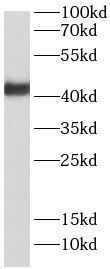Products
RNF34 antibody
| Synonyms: | E3 ubiquitin-protein ligase RNF34|Caspase regulator CARP1|Caspases-8 and -10-associated RING finger protein 1 (CARP-1)|FYVE-RING finger protein Momo|Human RING finger homologous to inhibitor of apoptosis protein (hRFI)|RING finger protein 34|RING finger protein RIFF|RING-type E3 ubiquitin transferase RNF34|RNF34 antibody | ||
| Catalogue No.: | FNab10144 | Reactivity: | Human |
| Host: | Rabbit | Tested Application: | WB |
| Clonality: | polyclonal | Isotype: | IgG |
| Size | Price |
|---|---|
| 100ug | Inquiry |
- SPECIFICATIONS
- FIGURES
- CONDITIONS
- FAQS
- Product Name
- RNF34 antibody
- Catalogue No.
- FNab10144
- Size
- 100μg
- Form
- liquid
- Purification
- Immunogen affinity purified
- Purity
- ≥95% as determined by SDS-PAGE
- Clonality
- polyclonal
- Isotype
- IgG
- Storage
- PBS with 0.02% sodium azide and 50% glycerol pH 7.3, -20℃ for 12 months(Avoid repeated freeze / thaw cycles.)
- Immunogen
- ring finger protein 34
- Alternative Names
- E3 ubiquitin-protein ligase RNF34|Caspase regulator CARP1|Caspases-8 and -10-associated RING finger protein 1 (CARP-1)|FYVE-RING finger protein Momo|Human RING finger homologous to inhibitor of apoptosis protein (hRFI)|RING finger protein 34|RING finger protein RIFF|RING-type E3 ubiquitin transferase RNF34|RNF34 antibody
- UniProt ID
- Q969K3
- Observed MW
- 41 kDa
- Tested Applications
- WB
- Recommended dilution
- WB: 1:200-1:2000
 Hela cells were subjected to SDS PAGE followed by western blot with FNab10144(RNF34 antibody) at dilution of 1:1000
Hela cells were subjected to SDS PAGE followed by western blot with FNab10144(RNF34 antibody) at dilution of 1:1000
- Background
- E3 ubiquitin-protein ligase that regulates several biological processes through the ubiquitin-mediated proteasomal degradation of various target proteins. Ubiquitinates the caspases CASP8 and CASP10, promoting their proteasomal degradation, to negatively regulate cell death downstream of death domain receptors in the extrinsic pathway of apoptosis(PubMed:15069192). May mediate 'Lys-48'-linked polyubiquitination of RIPK1 and its subsequent proteasomal degradation thereby indirectly regulating the tumor necrosis factor-mediated signaling pathway(Ref.13). Negatively regulates p53/TP53 through its direct ubiquitination and targeting to proteasomal degradation(PubMed:17121812). Indirectly, may also negatively regulate p53/TP53 through ubiquitination and degradation of SFN(PubMed:18382127). Mediates PPARGC1A proteasomal degradation probably through ubiquitination thereby indirectly regulating the metabolism of brown fat cells(PubMed:22064484). Possibly involved in innate immunity, through 'Lys-48'-linked polyubiquitination of NOD1 and its subsequent proteasomal degradation(PubMed:25012219).
How many times can antibodies be recycled?
First, usually it's not suggested to recycle antibodies. After use, buffer system of antibodies has changed. The storage condition of recycled antibodies for different customers also varies. Thus, the performance efficiency of recycled antibodies can’t be guaranteed. Besides, FineTest ever conducted the antibody recycling assay. Assay results show recycling times of different antibodies also varies. Usually, higher antibody titer allows more repeated use. Customers can determine based on experimental requirements.
Notes: After incubation, we recycle rest antibodies to centrifuge tube and store at 4℃. High titer antibodies can be stored for a minimum of one week. Reuse about three times.
What are components of FineTest antibody buffer?
Components of FineTest antibody buffer are usually PBS with proclin300 or sodium azide, BSA, 50% glycerol. Common preservative is proclin300 or sodium azide, which is widely applied in the lab and industry.
How about the storage temperature and duration of FineTest antibodies?
Most antibodies are stored at -20℃. Directly-labeled flow cytometry antibodies should be stored at 2 - 8℃. The shelf life is one year. If after sales issues for purchased antibodies appear, return or replacement is available. Usually, antibodies can be still used after the one-year warranty. We can offer technical support services.
Is dilution required for FineTest antibodies? What’s the dilute solution?
Directly-labeled flow cytometry antibodies are ready-to-use without dilution. Other antibodies are usually concentrated. Follow the dilution ratio suggested in the manual. Dilute solution for different experiments also varies. Common antibody dilution buffers are acceptable(e.g. PBST, TBST, antibody blocking buffer).
How to retrieve antibodies for immunohistochemistry?
Common retrieval buffers: Tris-EDTA Buffer(pH 9.0); Citrate Buffer(pH 6.0)
Heat induced antibody retrieval:
Method 1: Water-bath heating: Put the beaker with retrieval buffer and slide in the boiling water bath. Keep the boiling state for 15min. Naturally cool to room temperature;
Method 2: Microwave retrieval: Put the beaker with retrieval buffer and slide in the microwave oven. Heat at high power for 5min, Switch OFF for 3min, Heat at medium power for 5min. Naturally cool to room temperature.
How to choose secondary antibodies?
(1) Secondary antibodies react with primary antibodies. Thus, secondary antibodies should be against host species of primary antibodies. E.g. If the primary antibody is derived from rabbit, the relevant secondary antibody should be against rabbit. E.g. goat anti rabbit or donkey anti rabbit.
(2) Choose secondary antibody conjugates according to the experimental type, e.g. ELISA, WB, IHC etc. Common enzyme conjugated secondary antibodies are labelled by HRP, AP etc. Fluorescin or dye labelled secondary antibodies are applied in immunofluorescence and flow cytometry(e.g. FITC, Cy3).
